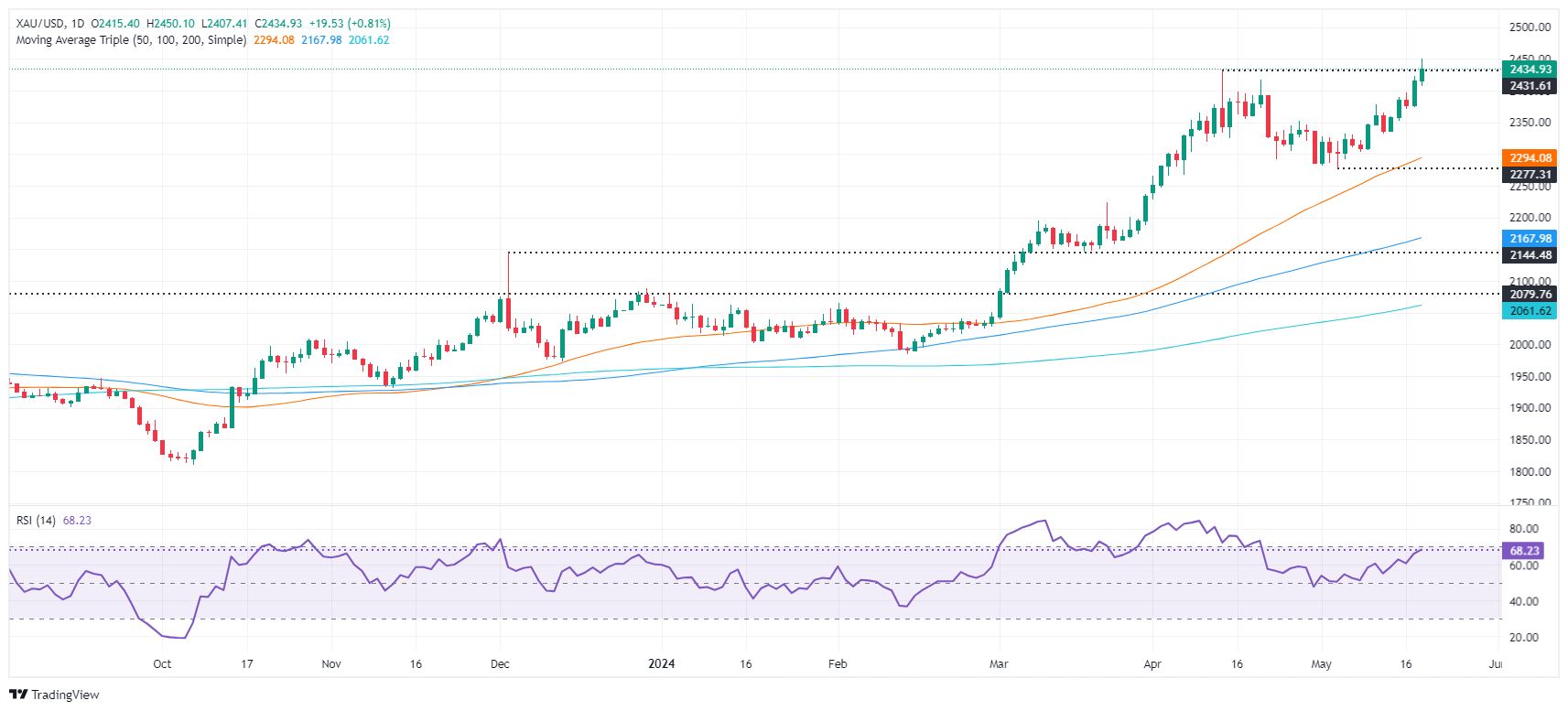Gold price soars, clings to gains above $2,400

- Gold extends gains, trading at $2,433, just below the all-time high of $2,450.
- Softer US inflation report boosts bets on Fed rate cuts with 76% odds for a September reduction.
- Investors anticipate two rate cuts by year-end, potentially lowering the Federal funds rate to 4.75%-5.00%.
Gold price extended its gains on Monday, yet it trades slightly below the all-time high of $2,450 reached during the Asian session amid increasing expectations that major central banks, including the Federal Reserve, might ease policy during 2024. The XAU/USD trades at $2,433, up 0.80%.
Market sentiment is a mixed bag, though slightly positive, with the S&P 500 and NASDAQ 100 gaining, while the Dow Jones is almost flat. This and last week’s softer-than-expected consumer inflation report in the United States (US) boosted bets that the Fed could slash borrowing costs as soon as September, according to CME FedWatch Tool data.
Odds that the Fed would cut rates by 25 bps in September are at 76%. Investors have begun to price in two cuts toward the end of the year, which would leave the fed funds rate at 4.75%-5.00%.
In the meantime, Federal Reserve (Fed) speakers would dominate the US economic docket during the week before the latest Fed meeting minutes were released on Wednesday. On Thursday, US Initial Jobless Claims are expected to show the labor market is cooling, along with the Chicago Fed National Activity Index.
Daily digest market movers: Gold price trends higher despite hawkish Fed commentary
- Gold price advances despite higher US Treasury yields and a weaker US Dollar. The US 10-year Treasury note yields 4.437% and is up one-and-a-half basis points (bps) from its opening level. DXY gains 0.06% to 104.55.
- Last week’s inflation data showed that underlying prices are easing. That reignited traders’ expectations that the US central bank would resume easing policy. However, they must be cautious as Fed officials pushed back against just one reading that inflation is moderating.
- Earlier, Fed speakers grabbed the headlines. First, Atlanta Fed President Raphael Bostic said that policy is restrictive and that it would take a while before they could be certain that inflation is headed to 2%. Vice-Chair Michel Barr echoed his words, noting the Fed will need to keep rates higher to “allow tight policy” to continue to do its work.
- Recently, Vice-Chair Philip Jefferson said it’s too easy to tell when the disinflation process will resume while stating that the policy rate is restrictive.
- As of writing, Cleveland Fed President Loretta Mester approved the latest CPI data and added that the risks of being “too restrictive” had gone down, while inflation risks are tilted to the upside.
Technical analysis: Gold price hits $2,450 as bulls target $2,500
Gold prices remain set to test higher prices after hitting a new all-time high of $2,450, which could open the door to further gains. Traders should know that momentum supports buyers as the Relative Strength Index (RSI) continues to aim higher but is not yet at overbought readings.
If XAU/USD breaches the all-time high, the next stop would be $2,475, followed by the $2,500 mark.
Conversely, if XAU/USD retreats below $2,400, that could expose the May 13 low at $2,332, followed by the May 8 low of $2,303. Once those levels are surpassed, the 50-day Simple Moving Average (SMA) at $2,284 will be up next.
Gold FAQs
Gold has played a key role in human’s history as it has been widely used as a store of value and medium of exchange. Currently, apart from its shine and usage for jewelry, the precious metal is widely seen as a safe-haven asset, meaning that it is considered a good investment during turbulent times. Gold is also widely seen as a hedge against inflation and against depreciating currencies as it doesn’t rely on any specific issuer or government.
Central banks are the biggest Gold holders. In their aim to support their currencies in turbulent times, central banks tend to diversify their reserves and buy Gold to improve the perceived strength of the economy and the currency. High Gold reserves can be a source of trust for a country’s solvency. Central banks added 1,136 tonnes of Gold worth around $70 billion to their reserves in 2022, according to data from the World Gold Council. This is the highest yearly purchase since records began. Central banks from emerging economies such as China, India and Turkey are quickly increasing their Gold reserves.
Gold has an inverse correlation with the US Dollar and US Treasuries, which are both major reserve and safe-haven assets. When the Dollar depreciates, Gold tends to rise, enabling investors and central banks to diversify their assets in turbulent times. Gold is also inversely correlated with risk assets. A rally in the stock market tends to weaken Gold price, while sell-offs in riskier markets tend to favor the precious metal.
The price can move due to a wide range of factors. Geopolitical instability or fears of a deep recession can quickly make Gold price escalate due to its safe-haven status. As a yield-less asset, Gold tends to rise with lower interest rates, while higher cost of money usually weighs down on the yellow metal. Still, most moves depend on how the US Dollar (USD) behaves as the asset is priced in dollars (XAU/USD). A strong Dollar tends to keep the price of Gold controlled, whereas a weaker Dollar is likely to push Gold prices up.
